
In filmmaking and video production, a crane shot is a shot taken by a camera on a moving crane or jib. Filmmaker D. W. Griffith created the first crane for his 1916 epic film Intolerance, with famed special effects pioneer Eiji Tsuburaya later constructing the first iron camera crane which is still adapted worldwide today. Most cranes accommodate both the camera and an operator, but some can be moved by remote control. Crane shots are often found in what are supposed to be emotional or suspenseful scenes. One example of this technique is the shots taken by remote cranes in the car-chase sequence of the 1985 film To Live and Die in L.A. Some filmmakers place the camera on a boom arm simply to make it easier to move around between ordinary set-ups.

A military engineering vehicle is a vehicle built for construction work or for the transportation of combat engineers on the battlefield. These vehicles may be modified civilian equipment or purpose-built military vehicles. The first appearance of such vehicles coincided with the appearance of the first tanks, these vehicles were modified Mark V tanks for bridging and mine clearance. Modern military engineering vehicles are expected to fulfill numerous roles, as such they undertake numerous forms, examples of roles include; bulldozers, cranes, graders, excavators, dump trucks, breaching vehicles, bridging vehicles, military ferries, amphibious crossing vehicles, and combat engineer section carriers.

A radio-controlled model is a model that is steerable with the use of radio control (RC). All types of model vehicles have had RC systems installed in them, including ground vehicles, boats, planes, helicopters and even submarines and scale railway locomotives.

Radio control is the use of control signals transmitted by radio to remotely control a device. Examples of simple radio control systems are garage door openers and keyless entry systems for vehicles, in which a small handheld radio transmitter unlocks or opens doors. Radio control is also used for control of model vehicles from a hand-held radio transmitter. Industrial, military, and scientific research organizations make use of radio-controlled vehicles as well. A rapidly growing application is control of unmanned aerial vehicles for both civilian and military uses, although these have more sophisticated control systems than traditional applications.

A forklift is a powered industrial truck used to lift and move materials over short distances. The forklift was developed in the early 20th century by various companies, including Clark, which made transmissions, and Yale & Towne Manufacturing, which made hoists. Since World War II, the use and development of the forklift truck have greatly expanded worldwide. Forklifts have become an indispensable piece of equipment in manufacturing and warehousing. In 2013, the top 20 manufacturers worldwide posted sales of $30.4 billion, with 944,405 machines sold.

A crane is a type of machine, generally equipped with a hoist rope, wire ropes or chains, and sheaves, that can be used both to lift and lower materials and to move them horizontally. It is mainly used for lifting heavy objects and transporting them to other places. The device uses one or more simple machines to create mechanical advantage and thus move loads beyond the normal capability of a human. Cranes are commonly employed in transportation for the loading and unloading of freight, in construction for the movement of materials, and in manufacturing for the assembling of heavy equipment.
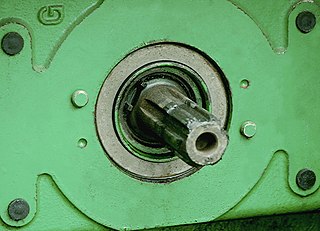
A power take-off or power takeoff (PTO) is one of several methods for taking power from a power source, such as a running engine, and transmitting it to an application such as an attached implement or separate machine.

A professional video camera is a high-end device for creating electronic moving images. Originally developed for use in television studios or with outside broadcast trucks, they are now also used for music videos, direct-to-video movies, corporate and educational videos, wedding videos, among other uses. Since the 2000s, most professional video cameras are digital professional video cameras.

An aerial work platform (AWP), also known as an aerial device, elevating work platform (EWP), cherry picker, bucket truck or mobile elevating work platform (MEWP) is a mechanical device used to provide temporary access for people or equipment to inaccessible areas, usually at height. There are distinct types of mechanized access platforms and the individual types may also be known as a "cherry picker", "boom lift" or "scissor lift".

A tow truck is a truck used to move disabled, improperly parked, impounded, or otherwise indisposed motor vehicles. This may involve recovering a vehicle damaged in an accident, returning one to a drivable surface in a mishap or inclement weather, or towing or transporting one via flatbed to a repair shop or other location.

In cinematography, a jib is any boom device used to mount a camera on one end, and a counterweight with camera controls on the other. In principle, it operates like a see-saw, with the balance point located closer to the counterweight, which allows the end of the arm with the camera to move through an extended arc. Typically a jib permits the camera to be moved vertically, horizontally, or a combination of the two. A small jib can be mounted on a tripod, but many larger, purpose-built jibs have their own support stands, often on wheels. Modern jibs are normally modular and can be assembled in various lengths.
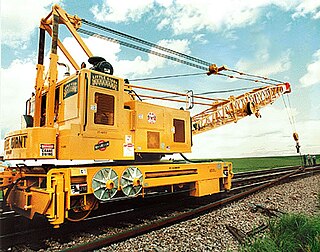
A railroad crane is a type of crane used on a railroad for one of three primary purposes: freight handling in goods yards, permanent way (PW) maintenance, and accident recovery work. Although the design differs according to the type of work, the basic configuration is similar in all cases: a rotating crane body is mounted on a sturdy chassis fitted with flanged wheels. The body supports the jib and provides all the lifting and operating mechanisms; on larger cranes, an operator's cabin is usually provided. The chassis is fitted with buffing (UK) and/or coupling gear to allow the crane to be moved by a locomotive, although many are also self-propelled to allow limited movement about a work site.

A gantry crane is a crane built atop a gantry, which is a structure used to straddle an object or workspace. They can range from enormous "full" gantry cranes, capable of lifting some of the heaviest loads in the world, to small shop cranes, used for tasks such as lifting automobile engines out of vehicles. They are also called portal cranes, the "portal" being the empty space straddled by the gantry.
The Manitowoc Company, Inc. was founded in 1902 and, through its wholly owned subsidiaries, designs, manufactures, markets, and supports mobile telescopic cranes, tower cranes, lattice-boom crawler cranes, and boom trucks under the Grove, Manitowoc, National Crane, Potain, Shuttlelift and Manitowoc Crane Care brand names.
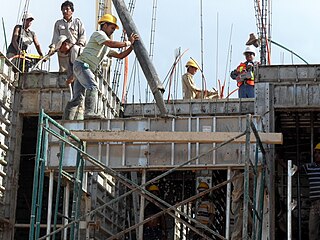
A concrete pump is a machine used for transferring liquid concrete by pumping. There are different types of concrete pumps.
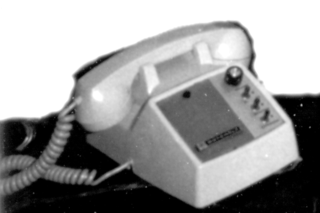
Remote controls are used any time a two-way radio base station is located away from the desk or office where communication originates. For example, a dispatch center for taxicabs may have an office downtown but have a base station on a distant mountain top. A Tone remote, also known as an EIA Tone remote, is a signaling system used to operate a two-way radio base station by some form of remote control.

A mobile crane is a cable-controlled crane mounted on crawlers or rubber-tired carriers or a hydraulic-powered crane with a telescoping boom mounted on truck-type carriers or as self-propelled models. They are designed to easily transport to a site and use with different types of load and cargo with little or no setup or assembly.

The International WorkStar is a line of severe duty trucks produced by Navistar, Inc. The WorkStar is the successor to the 7400 and 7600 series trucks produced by International. Starting in 2008 the "thousand series" name was dropped in favor of the WorkStar. This change was reflected in the physical construction of the truck in the form of a new hood and grill along with increased MaxxForce Engine options.
Outreach Offshore Ltd is a supplier of hydraulic cranes, lifting and access equipment. The company was founded in 1990 and its headquarters are in Falkirk, Scotland. Formerly a division of Outreach Ltd, Outreach Offshore continued after the formal disbanding of the parent company in May 2018.
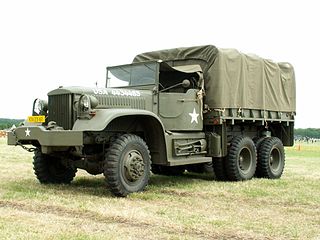
The Diamond T 4-ton 6×6 truck was a heavy tactical truck built for the United States Army during World War II. Its G-number was G-509. Cargo models were designed to transport a 4-ton (3,600 kg) load over all terrain in all weather. There were also wrecker, dump, and other models. They were replaced by the M39 series 5-ton 6×6 trucks in the 1950s.




















